The web commerce craze has taken the whole world by storm, and Australia hasn’t been left behind. The statistics on Australia’s eCommerce sector below demonstrate that the industry has increased since its launch in the 1990s.
To gain more insights into the sector’s recent development, we’ve compiled some statistics and facts on Australia’s ecommerce sector and how it can grow in the future.
Australia’s Ten Key eCommerce Statistics At a Glance
- In 2020, Australians spent $50.46 billion.
- In 2021, 9.1 million consumers in Australia shopped online.
- In July 2021, 22 million Australians visited the Woolworths website.
- A third of eCommerce sales in 2020 comprised various store purchases.
- Customers aged between 35-44 spend the most on eCommerce platforms.
- 66% of online stores in Australia use Australia post for shipping.
- The eCommerce sector accounted for 2% of the country’s GDP in 2020.
- In 2021, 79.7% of eCommerce purchases in Australia were made by eastern states.
- By December 202, there was a 55% increase in online shopping in Australia.
- In 20220, over 90% of Australians used their phones for shopping online.
Australian eCommerce Sales Stats
1. Australian Households using eCommerce Platforms
Data from Australia Post indicates that more than nine million Australian households bought a product on eCommerce platforms between July 2020 and June 2021. This adds up to 14.6% more consumers than the previous year.
2. Money Australians Spent on eCommerce in 2020
Australia Post’s eCommerce statistics also reveal that most consumers turned to digital platforms to buy products and spent over 50.5 billion; thus, the country’s year-over-year web commerce sales increased by 57%.
3. Aussies Purchasing Products from Stores they haven’t Used Previous
Aussies were more open to purchasing products from new eCommerce stores in 2020. In August, 22% of consumers bought goods from online stores they’d never bought from before.
4. Variety of Retail Store Purchases
The pandemic saw the introduction of restrictions and lockdowns. Consequently, Australians turned to an online variety of retail stores to get some semblance of normalcy. These stores got more business than any other online store. Variety store purchases accounted for a third of all online purchases in 2020.
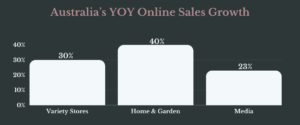
5. Australia’s YOY Online Sales Growth
Approximately 33% of Australian consumers purchased products from digital variety retail stores. All online retail stores recorded increased sales by the end of the 2020/2021 financial year.
Variety stores had a 30% year-over-year growth, while Home and garden retail stores recorded a 40% growth. The category that registered the smallest growth was media which had 23% YOY.
6. Best Times To Make Online Purchases
Since Australians spent most of their time at home and had more flexible working hours in 2020, afternoon purchases rose by 2.7%. Mid-evening online purchases decreased between April and December 2020. 28% of Australians bought products online in the mid-evening; in 2019, the number stood at 31%.
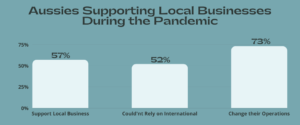
7. Aussies Supporting Local Businesses During the Pandemic
The COVID-19 pandemic disrupted the supply and shipping chains, impacting Australia’s international online market. Australians turned to local businesses for their needs. Reports from the Australia Post indicate that 57% of consumers sought to support local businesses when the pandemic broke out.
52% of respondents said they couldn’t rely on international shipping as it took a long time. 73% of Australian businesses had to change their operations and began using reliable local supply chains to avoid the international supply and shipping challenges brought about by the pandemic.
The eCommerce Sector
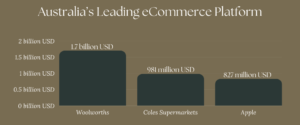
8. Australia’s Leading eCommerce Platform
Data from eCommerceDB shows that Woolworths was Australia’s leading eCommerce site in 2020, with a revenue of 1.7 billion USD. Unlike other international eCommerce platforms like eBay and Amazon, Woolworths generates most of its income from the Australian market.
Australia’s second-largest eCommerce site in 2020 was Coles Supermarkets which generated a revenue of 981 million USD — the income came from national sales. Australia’s third-largest web commerce site was Apple which generated 827 million USD in sales.
Apple was the only non-Australian-based business on the list reporting a 9.79 billion AUD revenue from Australia in 2020. The three retailers accounted for roughly 15% of Australia’s web commerce revenue.
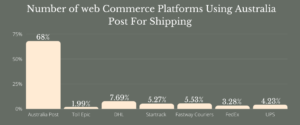
9. Number of web Commerce Platforms Using Australia Post For Shipping
Statistics from PipeCandy show that Australia Post is the most reliable and trusted eCommerce shipping partner, with around 68% of web commerce platforms for domestic product shipments.
Even though Australia post, other cheaper alternatives like Toll Epic are gaining traction. Toll IPEC now handles 1.99% of domestic deliveries.
Other companies providing shipping services include:
- DHL handles 7.69% of deliveries
- Startrack handles 5.27% of deliveries
- Fastway Couriers handles 5.53%of shipments
- FedEx handles 3.28% of deliveries
- UPS handles 4.23% of shipments
10. Busiest Web Commerce Periods in the Year
According to Australia’s Commonwealth bank (based on how Australians use debit and credit cards), in 2020, there was an increase in shopping frequency during Black Friday and Cyber Monday.
For instance, footwear and clothing sales increased by 140% in the three weeks leading to black Friday, while electronics and department stores more than doubled their sales. Specialty and Household items retail stores recorded a 92% and 95% sale increase, respectively.
Australia’s Web Commerce Shoppers Stats
11. Online Auctions and eCommerce Site Visits Based On Gender
Statista shows that in 2018, more men visited larger web platforms like Gumtree and eBay. For example, approximately 4.9 million male consumers visited eBay every month compared to 4.55 million women who visited the same platform. The same was seen with Gumtree, while Amazon had more female visitors than males.
12. Age-Wise Comparison of Online Purchase Habits
According to research conducted by Convento in 2018, Australians aged between 35 and 44 accounted for 24% of web commerce sales. Other age groups that also shop online frequently are people between 45 and 54 and those between 25 and 34.
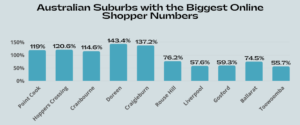
13. Australian Suburbs with the Biggest Online Shopper Numbers
Research conducted by Australia Post revealed that all the ten leading online destinations are currently located in Eastern Australia. Compared to 2019, the top five postcodes (all in Victoria) recorded more than double the purchase volume. The following are Australia’s most profitable destinations, along with their year-over-year growth:
- Point Cook, Victoria — 119%
- Hoppers Crossing, Victoria — 120.6%
- Cranbourne, Victoria — 114.6%
- Doreen, Victoria — 143.4%
- Craigieburn, Victoria — 137.2%
- Rouse Hill, New South Wales — 76.2%
- Liverpool, New South Wales — 57.6%
- Gosford, New South Wales — 59.3%
- Ballarat, New South Wales — 74.5%
- Toowoomba, Queensland — 55.7%
14. States that had the Most Online Purchases
According to Australia Post, in the 2020/2021 financial year, Australians residing in the Eastern States contributed the most to the country’s web commerce business. During that financial year, Queensland, Victoria, and New South Wales were the leading online shopper destinations; these states accounted for 79.7% of the total online sales.
New South Wales accounted for 31.6% of online purchases, while Queensland and Victoria accounted for 18.1% and 30% of all online sales, respectively. The other states accounted for the remaining 20.3%.
15. Increased eCommerce Site Use
In 2020, there was sustained participation in online shopping, with 82% of consumers buying products online. Regular shoppers who shopped online before the pandemic started purchasing products more frequently and from a broader section of retailers.
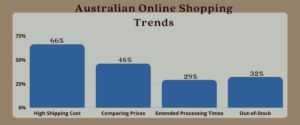
16. Australian Online Shopping Trends
The 2018 SAP Consumer Propensity research revealed that around 60% of online shoppers in Australia usually abandon their shopping carts. This behaviour is prevalent with shoppers looking to purchase furniture (65%) and clothes (60%).
The study also revealed that Australian shoppers are price-savvy, with 66% of shoppers abandoning potential buys if the shipping cost is high and 46% comparing cart prices among web commerce platforms.
Other reasons consumers abandon their shopping costs are extended processing times (29%) and out-of-stock products (32%).
17. Number of New Online Shoppers
According to the Australian Post, out of the nine million households that purchased products online in 2020, 10% were making online purchases for the first time. 93% of these first-time online purchases were made between March and December 2020.
18. Sustainability in eCommerce
A study conducted by KPMG on Australia’s eCommerce sector indicates that 80% of consumers buy goods from companies that value ESG (Environmental, Social and Governance). 54% of Australians also indicated that an eCommerce platform’s ecological stance affects their purchase decisions. Around 75% of Aussies also look at sustainability when making online purchases.
E-commerce Income Stats
19. Number of Aussies Using Their Phones To Shop Online
In a recent online shopping trends report, the Australia Post established that 91% of consumers use phones to shop online, while 76% of consumers also use laptops for online shopping. 60% of consumers use smart TVs to purchase products online, and 61% use tablets to make online purchases.
Overall, Australians used 4.4 gadgets to access the internet, with 83% using the internet to shop online.
20. Web Commerce’s Contribution to Australia’s GDP
A study on Australia’s logistics and freight market in 2020 revealed that the country’s eCommerce sector is growing. The report indicates that the sector contributed to Australia’s GDP by 1.80%.
21. Credit Card Use On eCommerce Platforms
Research conducted by PPRO in early 2020 established that more than half of online Aussie shoppers used their credit cards to purchase products online. 22% of the shoppers used e-wallets, while another 16% made bank transfers. The remaining shoppers relied on other payment methods like cash payments.
22. Card-not-present fraud Damages
According to the Australian Payments Network (APN), during the 2020/2021 financial year, there was a 15.4% decrease in fraudulent online retail transactions. As per the report, $447.2 million was paid out as card payment damages, with most of it (approximately $400 million) resulting from CNP fraud.
On the other hand, stolen and lost card fraud ($30.8 million) and skimming/counterfeit fraud ($14 million) recorded a 28.5% and 24.8% decline, respectively. Overall, Australia’s card fraud rate for the 2020/2021 financial year was 56 cents for every $ 1000.
Phone Web Commerce Stats
25. Phone Shoppers Completing Online Purchases
In 2019, PayPal’s mobile commerce index established that 55% of mobile buyers bought products at least once weekly. Additionally, 60% of the respondents indicated that they’d optimised their eCommerce platforms for phone use.
26. Australia’s Leading Phone Shopping Applications
42matters’s retail phone app statistics indicate that Aussie shoppers highly rate leading online platforms like eBay and Amazon, which have over 100 million downloads globally. Their global presence notwithstanding, these platforms aren’t in Australia’s top three shopping apps; eBay is ranked 5th, while Amazon is ranked 4th.
Australia’s leading shopping application is the Shop: package and order track which has 10 million downloads. Woolworths is the second-best shopping app, with more than one million downloads, while the third place is SHEIN, which has more than 100 million downloads globally.
27. Consumers Discovering New Brands
Hootsuite and We Are Social’s 2020 Digital in Australia report outlined the top methods Aussies use to discover new brands. Besides using search engines, 42% of shoppers indicated that TV advertisements inspired them to look up new brands.
Another 38% said they checked out new brands through referrals from friends or family. The report indicated that the least popular methods of discovering new brands were physical stores (25%) and social media (26%).
28. Amounts Aussies Spend Shopping Through Social Channels
A study on Australia’s online shopping behaviours released in late 2019 established that Australians spend around $16 billion on shopping using social platforms. This says a lot since Australians spend, on average, 7 hours per week on Instagram alone.
The report also revealed that 34% of consumers make impulse purchases when looking at goods on social platforms, which results in $860 being spent unplanned annually. The most popular digital platforms to shop on are as follows:
- Instagram — 9%
- Facebook — 22%
- Snapchat — 4%
- YouTube — 9%
- Pinterest — 4%
29. The Australian Phone eCommerce Market Growth Forecast
In 2020, a report by J.P Morgan indicated that Australia’s eCommerce payments include a segment of the country’s mobile commerce sector. The report highlights an expected 16.5% CAGR till 2023; this accounts for over 22 billion USD mobile commerce section’s market share.
The Impact of the Pandemic on Australia’s Web Commerce Sector
30. The Growth of Australia’s eCommerce Industry
The Australian Bureau of Statistics studied the pandemic’s impact on Australia’s eCommerce sector. The body collected 2020 online sales data throughout the country and compared it to 2019 sales data.
According to the study, in December 2020, online shopping increased by 55.2%. Even though the sector closed the year while recording enormous growth, October and November 2020 generated more sales (70% and 67.3%, respectively) compared to the same months in 2019.
31. Australia’s Web Commerce’s YOY Growth
According to the Australia Post, within a few weeks of Australia’s nationwide lockdown, the country’s web commerce sector saw a 135% YOY increase. All categories performed well, but the home, garden, and variety stores performed best with 177% and 188% YOY, respectively. The number of online products spent also increased by 95% YOY.
32. Post-Pandemic Online Marketing Budget
Data from consultancy.com.au indicates that small enterprises increased their online visibility after COVID-19, with 74% of their marketing budget spent on digital marketing.
Other entrepreneurship and SMB statistics indicate that 46% of small enterprises became more active on digital platforms, and 34% of them launched new websites as a result of the growth of the eCommerce sector during the pandemic.
33. Australia’s eCommerce Sector Growth Forecast
A recent report from GlobalData predicts that Australia’s online retail sector will grow steadily over the next few years and generate $77.1 billion in revenue by 2024. The primary driving factor for the sector’s fast growth is the change in consumer shopping habits due to the restrictions brought about by the pandemic.






